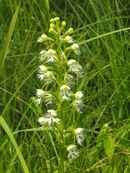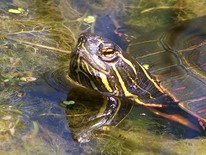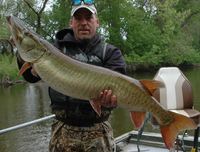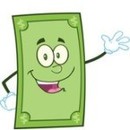|
Horicon Marsh, one of the largest marshlands in the world, is an example of a very large effort to restore a complex flowage wetland.
 The Wisconsin Wetland Conservation Trust (WWCT) is a wetland mitigation in-lieu fee (ILF) program administered by the Wisconsin DNR. Customers who impact wetlands may be required to buy wetland mitigation credits from the WWCT to offset their impacts. The WWCT then awards the funds generated from credit sales to applicants to implement wetland restoration projects. The Program targets projects that restore, enhance, and preserve wetland resources throughout Wisconsin, including the Rock River basin.
The WWCT anticipates annually issuing an RFP soliciting potential projects, but exact timing and in what watersheds will depend on current funding available. For more information, please see the WWCT website or contact Josh Brown, ILF Program Coordinator, at 608-266-1902 or JoshuaA.Brown@wi.gov. .
|

Sector Team Meeting
The next Ag Sector Team will be meeting July 18, from 9-12, at the UW Extension Office in January. While this meeting is open to the public, it is a working meeting with focused tasks and limited opportunities for discussion. Click HERE to view the agenda.
If
you are interested in the latest equipment and technology for professional
manure management, plan to attend the 2017 North American Manure Expo on August
22 and 23, 2017. Wisconsin hosts the Expo this year and it will be held at the
University of Wisconsin-Madison Arlington Agricultural Research Station. Read more HERE.
This was another difficult planting season for many farmers in the region. Excessive rainfall caused widespread damage to seeded crops, or prevented planting all together. Many farmers have been forced to replant entire fields. This publication from UW Extension provides information for farmers and explains alternatives.
Fond du Lac County: Frost Seeding Clover? It Works!
Neil Drummy, a Wisconsin row crop farmer, owns and operates land in Dodge, Fond du Lac and Columbia Counties. Neil is consciously a good steward of the land in the conservation decisions he makes, while also looking for ways to increase yields without causing undo harm to the land he operates. With the help of NRCS, Neil frost seeded 24 acres of crimson clover into existing wheat. Read the full article here.
The USDA's Natural Resources Conservation Service and the Wisconsin Department of Agriculture have entered an agreement to launch a new demonstration farm network in Kewaunee and Door counties. The project is being put together in cooperation with Peninsula Pride Farms, which is a farmer-led sustainability group. Read more...
The Animal Agriculture Education Project includes multimedia
features such as videos and virtual tours of farms and discusses topics
including advances in technologies and
production systems, measures to protect water quality, and issues involved in
on-farm decision-making about manure management.
|

Sector Team
WDNR staff are finalizing the first draft of the Monitoring Section for the Rock River Recovery Implementation Plan. Once this is complete, a Monitoring Sector Team meeting will be scheduled to present the draft to our basin partners and provide an opportunity for input and feedback. If you would like to be part of the Monitoring Sector Team, please contact Mike Sorge.
|
 Large River Sites
WDNR will be conducting the Large River Index of Biotic Integrity Fish sampling on the Rock River at 15 Locations. We will be sampling from 15 locations on the Rock River from Beloit to Horicon. We will also be looking at one site each on the Crawfish River, Bark River, and the Yahara River.
Large River Macroinvertebrate samples will also be collected at four locations on the Rock River. These samplers will be deployed in July and collected six weeks later in August. Freshwater mussel surveys will be conducted at four locations on the Rock River as well. This will be a comprehensive look at the biological communities at these four locations surveying the fish, macroinvertebrates, and mussels.
|

Webpage (beta)
The main Rock River Recovery webpage serves as the entry point to the more detailed "dynamic web pages" that we will use to provide regular updates and reporting on progress in TMDL Implementation.
While we have already completed numerous updates to the "dynamic web pages", more work will continue through the year as we pull in information, finalize the Implementation Plan, and gather information from project partners throughout our Rock River Basin community. Some highlights of the new dynamic pages include;
In development of the new "dynamic web pages" portal a great deal of programming work was required to build linkages across databases, web servers, and GIS systems. While there are still a few bugs to work through, we felt this "beta" version should be open for public trial. Please provide any feedback to Mark Riedel.
|

The proposed “Evaluation for Stormwater Infiltration - Technical Standard 1002” has been updated. The technical standard revises the procedures, updates the submittal requirements, and clarifies methods that can be used to design infiltration systems in compliance with NR 151, Wis. Adm. Code.
The draft technical standard concerning storm water is now available for review and comment on the Proposed DNR Program Guidance Web page. "Evaluation for Stormwater Infiltration - Technical Standard 1002” is open for comment until July 5, 2017.
The Department is soliciting comments from the public on this draft technical standard. Once the 21 day notice period is complete, all comments will be considered by the Department. After considering all public comments, revisions may be made to the guidance document and final guidance will be made available to internal and external stakeholders. Comments related to this draft guidance document should be sent to: DNRTechnicalStandards@Wisconsin.gov.
Green infrastructure can be discouraged or even prohibited by outdated, poorly worded or ambiguous codes and ordinances. Cooperation among county and municipal staff in zoning, land use, urban forestry, stormwater and engineering are key to evaluating barriers to green infrastructure in our communities. A team led by UW-Greenbay Seagrant has developed a workbook that will help communities review, revise and prioritize their local codes and ordinances to promote and advance green infrastructure implementation. Download the entire workbook or one of its main sections below.
|

Updated resources are online to assist communities and permittees exploring the MDV. While WDNR staff continue to receive numerous general and "hypothetical" inquiries on the MDV, we have also received a number of formal applications for the MDV.
For communities that wish to explore their eligibility, we encourage you to check out the "online eligibility questionnaire" to easily determine if you qualify for the MDV.
During the 2017 County Conservationist's meeting, Andrew Craig, WDNR, will be presenting updates on the MDV and discussing the options for counties exploring if they want to participate in this program. Andrew will discuss county eligibility, obligations, logistics, program logistics, and other considerations during his presentation.
|

Madison, Wis. – June 8, 2017 – The USDA Natural Resources Conservation Service (NRCS) today announced that the agency will award more than $22.6 million to drive public and private sector innovation in resource conservation. The agency is investing in 33 projects nationwide through its competitive Conservation Innovation Grants (CIG) program, which helps develop the tools, technologies, and strategies to support next-generation conservation efforts on working lands and develop market-based solutions to resource challenges. Public and private grantees - including non-governmental organizations, American Indian tribes, academic institutions and local government entities - will leverage the federal investment by at least matching it.
|
|